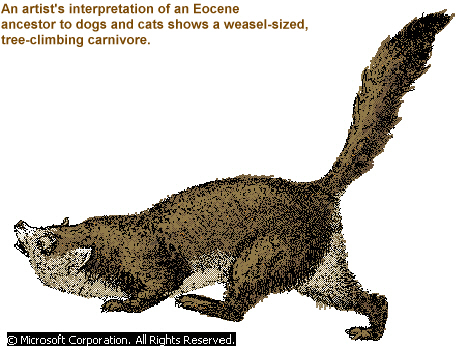 and
bush dogs. The dog family is known scientifically as Canidae, and
its members are commonly called canids or canines.
and
bush dogs. The dog family is known scientifically as Canidae, and
its members are commonly called canids or canines.The Dog Family
© Microsoft Corporation. All Rights Reserved.
The Dog Family is a group of intelligent, meat eating mammals that
includes domestic dogs and their relatives, coyotes, wolves,
foxes, jackals, dholes, raccoon dogs,  and
bush dogs. The dog family is known scientifically as Canidae, and
its members are commonly called canids or canines.
and
bush dogs. The dog family is known scientifically as Canidae, and
its members are commonly called canids or canines.
The earliest known doglike animals can be traced to the Eocene
Epoch, dating from 55 to 38 million years ago. Today, canines
live on every continent except Antarctica. Their presence on many
islands-including the island continent of Australia-is the result of
introduction by humans. Wild Australian dingos, 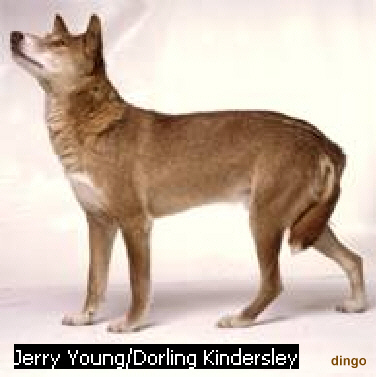 for
example, were probably brought to the continent as domestic dogs by
aboriginal people thousands of years ago.
for
example, were probably brought to the continent as domestic dogs by
aboriginal people thousands of years ago.
Canines thrive in a variety of habitats. Bush dogs, for example live
in the humid tropical forests of South and Central America, while
arctic foxes inhabit the ice floes and arctic tundra of the far
north. Fennecs survive in the arid deserts of North Africa and the
Middle East. A few dog species, such as 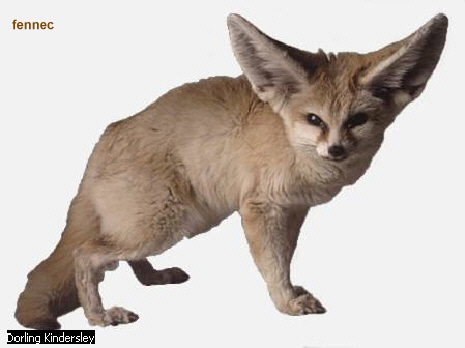 gray
wolves and red foxes, have extraordinarily broad distributions that
span several continents with a variety of environmental conditions.
Some dogs have evolved adaptations for hunting and evading predators
in unique habitats-gray foxes are able to climb low trees; many
dogs are excellent swimmers; and the bush dog is even an accomplished diver.
gray
wolves and red foxes, have extraordinarily broad distributions that
span several continents with a variety of environmental conditions.
Some dogs have evolved adaptations for hunting and evading predators
in unique habitats-gray foxes are able to climb low trees; many
dogs are excellent swimmers; and the bush dog is even an accomplished diver.
Currently, there is considerable interest but little consensus about how members of the dog family are related to each other. Domestic dogs, wolves, most foxes, coyotes, and jackals are clearly closely related. The relationships of raccoon dogs, African hunting dogs, bat-eared foxes, bush dogs, and dholes are less clear. Scientists agree, however, that the nearest relatives of the dog family are the bears, raccoons, weasels, and probably seals and sea lions.
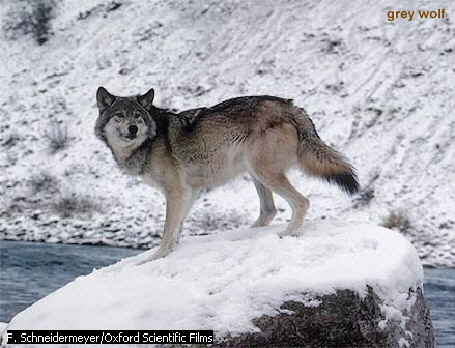
PHYSICAL CHARACTERISTICS
A number of physical traits distinguish the canines. Intermediate in size among mammals, canines range from the tiny fennec (above left), which weighs less than 4 pounds to the imposingly large gray wolf (right), which can reach 176 pounds. Most canines have compact, fur-covered bodies and long, bushy tails. Many have a patch of dark fur on the top of the tail near its base, marking the position of a scent gland. Canines have a long, pointed snout and mouth. Their ears are usually erect, often pointed, and can be quite large in some species; bat-eared foxes, for example, were named for their conspicuously large, wide ears that better resemble those of a bat than a fox.
Canines have a large number of powerfully built teeth used for killing and holding prey, in fighting, and in threat displays. While most canines have 42 teeth, some species such as bush dogs have only 38 teeth while bat-eared foxes have 50. Like humans, canines have different types of teeth that are distinguished by shape, position in the mouth, and function. The chisel-like incisors, used for cutting food and in grooming, are located in the front of the mouth. The incisors are followed by a pair of dagger-shaped canine teeth used in fighting and hunting. Premolars and molars, located near the back of the mouth, are used for grasping, slicing, and crushing meat and bone. The molars at the very back of the mouth are adapted for feeding on items such as insects, fruit, and leafy vegetation, as well as meat. Some canines include a high proportion of fruits, seeds, and other vegetable matter in their diets.
All of the canines are excellent hunters, with keen senses of smelling and hearing, although their eyesight is not exceptional. They usually prey on mice and other rodents, rabbits, antelope, caribou, and deer-depending on their species and habitat. Canines are well adapted for long-distance pursuits of prey. They can run exceptionally fast and have remarkable endurance for covering long distances. For example, greyhounds have been clocked at 44 mph and African hunting dogs can maintain speeds of 31 to 37 mph for several kilometers.
A number of physical adaptations enable canines to maintain high speeds over great distances. They have long leg, wrist, and ankle bones and they stand on their toes rather than on flat feet. These characteristics give canines a long stride that is further lengthened when the animal arches its backbone as it runs. Canines have small feet, and in most cases their feet have only four toes in contact with the ground. A small fifth toe, called the dewclaw, is usually present high up on both forefeet. All toes have strong, blunt claws. The small size and weight of their feet and limbs require less energy to move, enabling canines to run more efficiently than heavier-limbed animals.
REPRODUCTION
Canine reproduction is distinguished by large litters of up to 15 pups, although 6 to 7 is more common, usually born once a year. canine gestation periods range from 51 to 80 days. The young are blind and helpless at birth and require an extended period of parental care. Pups consume only their mother's milk until two to six weeks in age, when they learn to eat solid food as adult animals bring them dead prey or regurgitate partially digested food. After about a year, most canine pups reach sexual maturity, although the larger species, such as the gray wolf, can take up to three years to mature.
Mating occurs when female canines are in heat, a time when hormonal changes make females both attractive and attracted to males. In most canine species, sexually mature females are in heat once a year. Domestic dogs are often in heat twice a year. Mating in canines includes a distinctive feature called the copulatory tie. Following mating, the male and female reproductive organs remain linked together for up to an hour. This adaptation may have evolved to prevent other males from mating with the female during this time.
TYPES OF CANINES

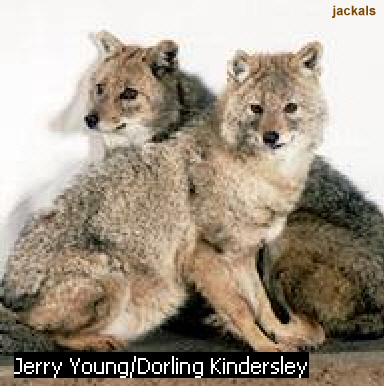
The most familiar members of the dog family belong to the genus Canis. These include domestic dogs, wolves, coyotes, and jackals. Wolves are the largest wild members of the dog family. Two species are alive today: gray wolves (also called timber wolves) and red wolves. Gray wolves once ranged throughout most of the northern hemisphere, but they are now found in just a few wild areas of northern North America and Asia, particularly in Siberia. These animals are well known for their pack structure and complex social behavior. Red wolves were once widespread in the southeastern United States, but they are now nearly extinct in the wild. Maintained in captivity, they have been reintroduced in North Carolina but are still threatened by habitat destruction and by interbreeding with coyotes.
Domestic dogs are derived from and are still very closely related to gray wolves. In fact, many scientists consider them to be members of the same species. Domestic dogs have been selectively bred by people into a great many shapes and sizes. They range from tiny chihuahuas and other toy breeds weighing less that 2 pounds to huge mastiffs weighing more than 176 pounds.
Coyotes are similar to wolves in shape and in many of their habits, but they are substantially smaller, weighing up to about 33 pounds. Like wolves, coyotes are social animals that often form packs, although coyote packs are usually smaller in number.
Jackals include four species found in the eastern hemisphere from Africa to central Asia. They are slender animals, even smaller than coyotes, with large, upright ears and bushy tails. They may live near villages and towns, where they sometimes earn a reputation as scavengers and livestock predators.
With about 21 distinct species, foxes comprise the largest group of
canines. Foxes are small, ranging in size from 3 to 20 pounds. They
have sharply pointed 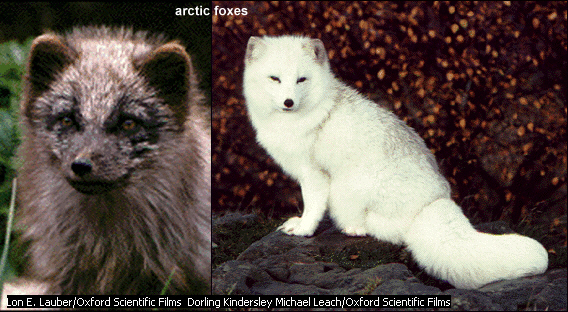 muzzles,
long and bushy tails, and large ears. Many foxes hunt by stalking
prey and then leaping on it with a distinctive, stiff-legged pounce.
Once thought to be solitary animals, foxes are now known to live in
groups of up to six individuals.
muzzles,
long and bushy tails, and large ears. Many foxes hunt by stalking
prey and then leaping on it with a distinctive, stiff-legged pounce.
Once thought to be solitary animals, foxes are now known to live in
groups of up to six individuals.
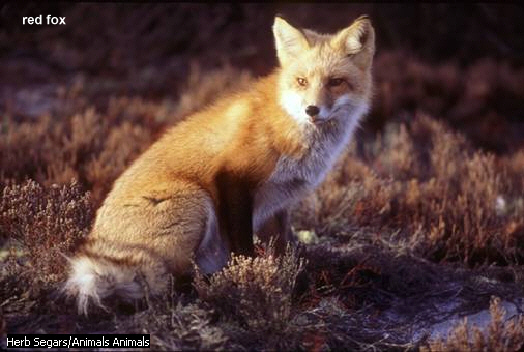
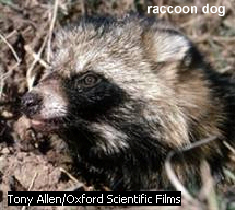 Despite
the fact that the raccoon dog, Nyctereutes procyonoides, looks,
unsurprisingly, like a raccoon, and does not bark, it is indeed a
member of the canid family. Known as the Ussurian raccoon, it was
introduced into Russian fur farms in the 1920s. Since the raccoon dog
frequently carries rabies, its proliferation in the wild has been
closely monitored and discouraged.
Despite
the fact that the raccoon dog, Nyctereutes procyonoides, looks,
unsurprisingly, like a raccoon, and does not bark, it is indeed a
member of the canid family. Known as the Ussurian raccoon, it was
introduced into Russian fur farms in the 1920s. Since the raccoon dog
frequently carries rabies, its proliferation in the wild has been
closely monitored and discouraged.The remaining canines are each highly distinctive. Raccoon dogs (above left) and bush dogs are the least doglike canines in appearance. Raccoon dogs, found in eastern Asia, have stubby legs, a stout body, short ears, shaggy fur, and a black face mask that resembles a raccoon's. Bush dogs, found only in South and Central America, look more like small bears than dogs: they have short legs, a compact body, and small ears. Bush dogs probably hunt in groups, but they are rare animals and little is known of their biology in the wild.
SOCIAL BEHAVIOR
Canines are often social animals, living and hunting in groups with complex communication systems and organizational structures. Canines communicate with vocalizations-usually barks, whimpers, growls, and howls. Canines also use body positions, head movements, and scents from scent glands to mark hunting territories, display authority, or advertise their receptivity to mating.
Social behavior among canines is based on the family group, which centers on a breeding pair. In wolves, for example, the breeding male, called the alpha, maintains dominance over other pack members using dominant body postures, facial displays, vocalizations such as growls and barks, scent marking, and when necessary, fighting. The second in charge, known as the beta, is the breeding female.
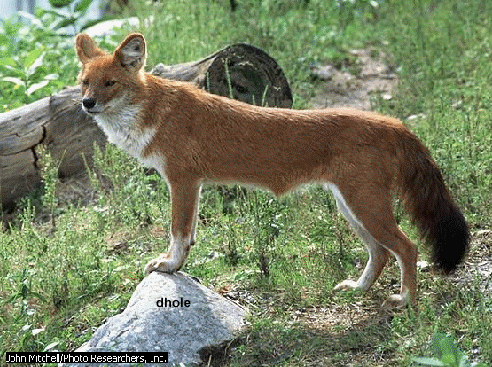 The
size and composition of the family group varies from species to
species. It is also influenced by the available food supply and by
the habitat where the animals live. African hunting dogs are perhaps
the most strongly social of all canines. They have been known to
gather in packs of hundreds of individuals, but the usual number
ranges from 10 to 30. The dominant female is typically the only
female in the pack to breed, but all pack members help to raise the
young by regurgitating food for the pups. Sick or injured adults are
also assisted in the same way. Quarrels in the pack are unusual, and
serious fights are rare. Unlike almost all other mammals, young
females of this species-instead of young males-leave the pack to
breed with members of other packs.
The
size and composition of the family group varies from species to
species. It is also influenced by the available food supply and by
the habitat where the animals live. African hunting dogs are perhaps
the most strongly social of all canines. They have been known to
gather in packs of hundreds of individuals, but the usual number
ranges from 10 to 30. The dominant female is typically the only
female in the pack to breed, but all pack members help to raise the
young by regurgitating food for the pups. Sick or injured adults are
also assisted in the same way. Quarrels in the pack are unusual, and
serious fights are rare. Unlike almost all other mammals, young
females of this species-instead of young males-leave the pack to
breed with members of other packs.
Canine packs, especially African hunting dogs and dholes, often hunt cooperatively, enabling them to pursue and kill much larger animals. They are able to do this using a technique called relay hunting, in which one member of the pack chases prey, then another takes over, followed by another, continuing until the prey animal is exhausted. The canines then attack and kill the prey.
Red foxes live in much smaller groups and usually hunt alone. A monogamous male and female pair typically defends a territory in which they hunt and raise their young. Sometimes several female foxes, usually a mother and her daughters, are found with a single male. The younger adults are helpers, assisting the breeding pair in territorial defense and providing food for the young.
HUMANS AND THE DOG FAMILY
 One
member of canineae, the domestic dog, shares a special relationship
with human beings. Records of dogs helping humans date from about
4500 years ago, but the association is thousands of years older. The
first domesticated dogs were wolf pups. Scientists think that the
highly social behavior of wolves allowed them to accept a
relationship with humans and to become part of a human family. The
first domesticated dogs used their excellent scent and hearing to
help humans hunt for food. They also probably served as sentinels,
warning of predators or other intruders. Ancient breeds of dogs
include salukis and basenjis, which exist today almost exactly as
they appear in carvings and paintings from ancient Egypt. Since then,
dogs have been selectively bred to bring out special traits that are
useful to people. Dogs today are used for hunting, herding, guarding,
and simply providing companionship. The American Kennel Club now
recognizes more than 100 breeds.
One
member of canineae, the domestic dog, shares a special relationship
with human beings. Records of dogs helping humans date from about
4500 years ago, but the association is thousands of years older. The
first domesticated dogs were wolf pups. Scientists think that the
highly social behavior of wolves allowed them to accept a
relationship with humans and to become part of a human family. The
first domesticated dogs used their excellent scent and hearing to
help humans hunt for food. They also probably served as sentinels,
warning of predators or other intruders. Ancient breeds of dogs
include salukis and basenjis, which exist today almost exactly as
they appear in carvings and paintings from ancient Egypt. Since then,
dogs have been selectively bred to bring out special traits that are
useful to people. Dogs today are used for hunting, herding, guarding,
and simply providing companionship. The American Kennel Club now
recognizes more than 100 breeds.
Until recent decades, many wild canines were hunted by humans for bounties and were considered scourges to livestock and other wildlife. Habitat destruction has also hurt some canine populations. The elimination of coyotes and foxes from some areas has resulted in huge increases in rodent populations that eat vegetation intended for desirable livestock and wildlife.
Contributed By:
Philip Myers